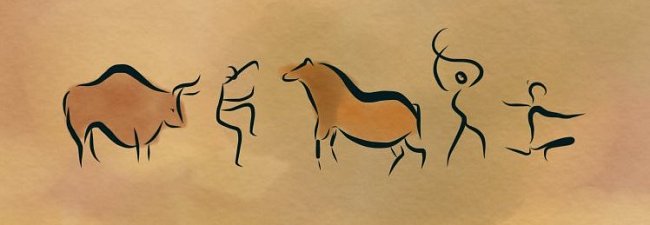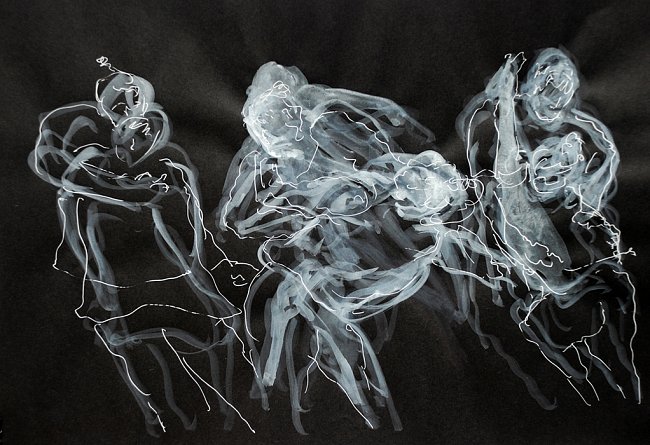
Our second week of research for the Dancing in Caves project at Pavilion Dance South West culminated in a sharing of some of our early ideas for new work Beneath Our Feet in the PDSW theatre, lit by torches. Our audience were really generous in feeding back about their experience of the work, and I wanted to jot down some of the things I learnt from their responses, as well as other key ideas from the second week:
Key things:
- My focus when researching ideas for the new piece so far has often been on the experience of the audience e.g. leaving space for them, actively making contact with them, crowding them, making them disappear, leading them, abandoning them. When we shared the work and had a group of about 20 people with us for the first time, I was struck by the way in which the beams of the torches often picked up on other people in the space even when designed to focus very closely on the dancers. ‘We’re in it together’ I thought, it is about our experience, the ground beneath our feet.
- However, in order to emphasise what it feels like to be drawn into something as a group, it is also important to explore what it feels like when we’re not ‘in it together’, because being underground is certainly not all about feeling safe and secure. Therefore I’m wondering how to introduce more opportunities for conflict within the piece (I’ve tried, but this is not emerging as a dominant feeling yet). The dancers described that in their first encounter with a larger audience, they felt they were being a lot more tentative than they might be if they were more familiar with the material and the context. They were very concerned to take care of the audience in that experience, making sure they were okay and didn’t get pushed inadvertently or mis-step in the darkness for example. This is of course important, and there will be time for that in the work. But how about what it feels like to be uncomfortable, to split the audience up, to ask them to leave hurriedly without explanation, to take the light out?
- This will be a piece about unsettling as well as settling – we need to negotiate a relationship with the audience that enables them to feel open to the experience of the work without that being contingent on them feeling completely comfortable all the way through. Similarly, the piece will not only explore the beauty of the earliest artworks created underground for example, it also needs to reflect on the extraordinary, back-breaking, brutal act of millions and millions of picks carving out/hacking at the underground by hand - “the men who toiled so long ago to leave us this legacy of beauty” (from Beer Quarry Caves exhibition) and the loss of so many hundreds and thousands of men in this process. “Managing the shift between brush strokes and pick marks” – I wrote this as a passing comment in my notes and think it actually sums up an overall need that our dramaturg Tom Cornford has reminded me about, to integrate different kinds of experience into the work.
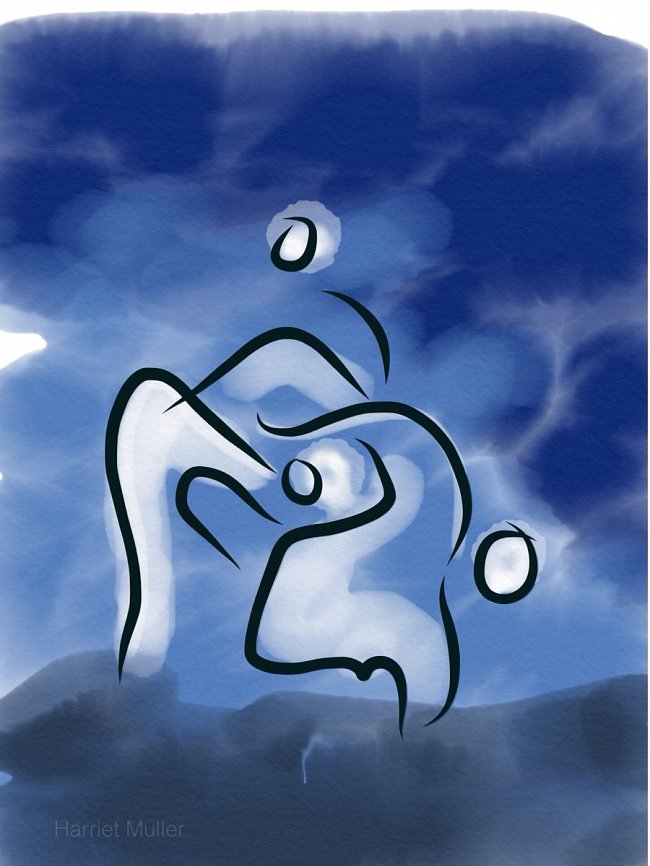
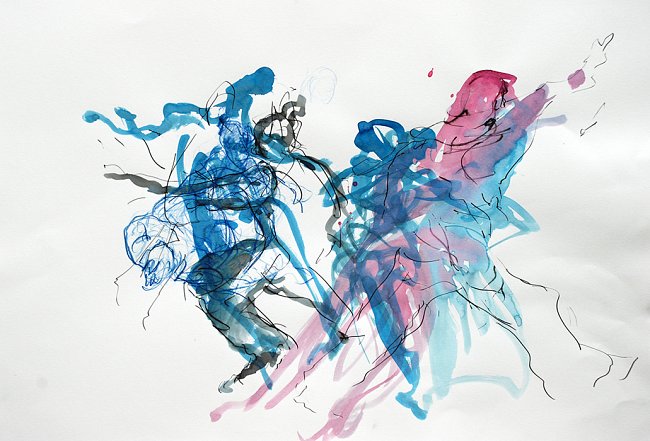
- Following on from this, I am reminded, like last week, about the need for variation within the overall pace of the piece. Everything that we have so far is beginning to feel very similar, in spite of my best efforts to try to introduce change. Tom has suggested a need to intensify the feeling of different sections in order to address this, as we will have limited time underground to allow our story unravel (so we have to move on quite quickly from a ‘settling in’/’taking care’ mode to be able to progress to some of our other more difficult ideas). We need to find a more contrasting dynamic to our movement, to the sound, to the text, to the way in which we interact with the audience, to the qualities with which we light each section (when and where do we give the audience the capacity to light themselves, the space?), to the journey round the space and the way in which the audience undertake that journey (different relationships with the space) e.g. as a group, at the edges, single file, split in all directions for example.
- The work continues to focus primarily on the theme of disorientation, but it’s important to also find places to ‘land’ or ‘anchor points’ throughout the piece. For example, it would be my preference to work only with light we introduce into the caves or underground spaces during the performance (for our research, we focussed on using torches), although I expect there may be a requirement to have a certain level of floor-lighting where this is available in some of our partner underground sites. In low light, it is of course difficult for everyone in the audience to see everything that’s happening all the time. For me, this is an important way of contributing to the sensation of disorientation. However, from time to time (when it makes sense within the story-telling) we have the opportunity to arrive at a well-lit moment, seeing one of the dancers’ faces or seeing everyone for a moment, or drawing attention to a particular part of the underground space itself for example. When the text for the piece is more developed, it will also help us with these ‘landings’. Whether sung or spoken, text will help us to prevent the piece from becoming too amorphous, moving aimlessly from sensation to sensation, as it will help us to suggest how these sensations might relate to real experience – things that have happened, things that might happen, things that are happening now (without needing to be too literal).
- In the ‘blackout section’ we shared last week, we worked on choreographing with sound as well as movement, and animating a pitch black space with fragments of a poem Anna Selby wrote for us called ‘Beneath Our Feet’.
“Listen.
Can you hear it?
The mountain under the mountain
Lake under lake
River under river
Feet beneath our feet”
In this blackout section (and throughout all the material we shared, based on some of the audience feedback) we create the sense of an enchantment, and also of something tantalising, not quite fully revealed. We worked on leaving sufficient space and time for the audience to become aware of the sounds naturally occurring in the space during this section, as well as the sounds they were making. We decided that the words the dancers would use at this point could never be too loud, never too ‘present’ in the space at the same time as the audience, because we are trying to give the sense that they are the voices of all the people through time who have ever been here, underground. Sometimes the voices meet each other briefly, as if they’re time-travellers and they just happen to have arrived in the same time for just a moment, but then they are carried away again. A couple of times in the material we shared last week we also explored what it could be like to ‘capture’ one of the voices in the torchlight (we used silhouette, so the dancers' faces couldn’t be seen, making them anonymous), for them to realise they had been caught and weren’t supposed to be there, and then to scuttle out of the light like insects. I feel like there’s something in this that is relevant to the whole piece, and to the characterisation of the dancers. At each moment in the piece we have the sense that they will be there only briefly, and that they could vanish again in an instant, landing in another place (and time) in the cave and carrying us with them, enabling us to experience it with them. It will only be the live musician who will be present in the same time as the audience.
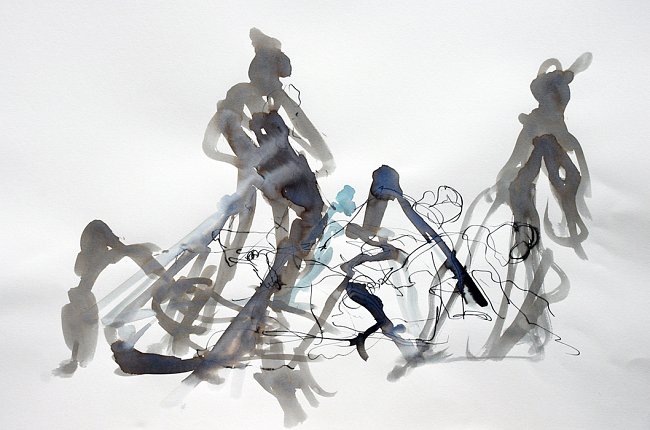
- Anna had some further thoughts about the potential characterisation of the dancers as they shift between different sections within the piece, and we talked about the integration of three different ‘elements’: the burrowing, creeping Python; the giant, sculptural, strong, dangerous, we only ever catch a part of the movement as it cannot be contained by the cave; and the moth, darting, childlike, curious, never settling. I think we’d also need something more ‘jagged’ and hard-edged here as well – these could all relate to the quality of the torchlight as much as to the quality of the movement itself. I also began to talk with Anna about the different feelings we would want the whole work to encompass – e.g. something poignant; something exhilarated, joyful; something uncomfortable, disorienting etc.
- I was struck by the way in which the process of making this work for an underground site, to be performed by torchlight, required/reminded me to rely on my instincts choreographically. It’s impossible to document the material in the way I usually would because I cannot capture it on my video camera; when it’s dark I can’t photograph or take notes. Therefore I can only respond in the moment, and I’m reminded of the particular ‘live-ness’ of the material in this site. The dancers also talked about only ‘knowing’ the piece when the lights were out and they had their torch to find the way. Sometimes things took longer to piece together because of this (it was difficult to settle on a ‘torch-lighting plan’ because we had so many interesting options to explore). We often talked about the need to leave certain sections improvised in order to enable the dancers to experience a ‘discovery’ of the material in the performance. I also found that my senses became heightened as we worked in constant blackout, which meant I had more rather than less information to go on. I became acutely aware of what the dancers were doing when they turned their torches off, not only when I could see them clearly.
- This heightening of senses means that the simplest things are usually the most effective (actually I think this is always the case, but it’s particularly pertinent here). It will be important to pay attention to simple elements like stillness, lights on, lights off, silence, giving more time to hear movement/sound without light, lighting the cave without bodies moving for example.
Of course there were also many other discoveries, but this gives a few initial ideas. Go here to read thoughts from week 1 of our research process and here to read some of our dramaturg Tom Cornford’s reflections on this and other collaborations.
Thank you to the team at PDSW for supporting our residency, to dance artists Kirsty Arnold, Kate Cox, KJ Lawson-Mortimer and Lucy Starkey, along with writer Anna Selby, composer Max Perryment, theatre director Tom Cornford and the many individuals who responded to our callout for information for giving their time to our research so far. Thanks also to artists Harriet Muller and Jan Roe for being with us in the studio at PDSW and sharing their responses with us.
The R&D for the Dancing in Caves project is supported by the National Lottery through Arts Council England, Pavilion Dance South West (Katie Green/Made By Katie Green are Discovery Artists at PDSW), and South East Dance in partnership with the Jerwood Charitable Foundation.
